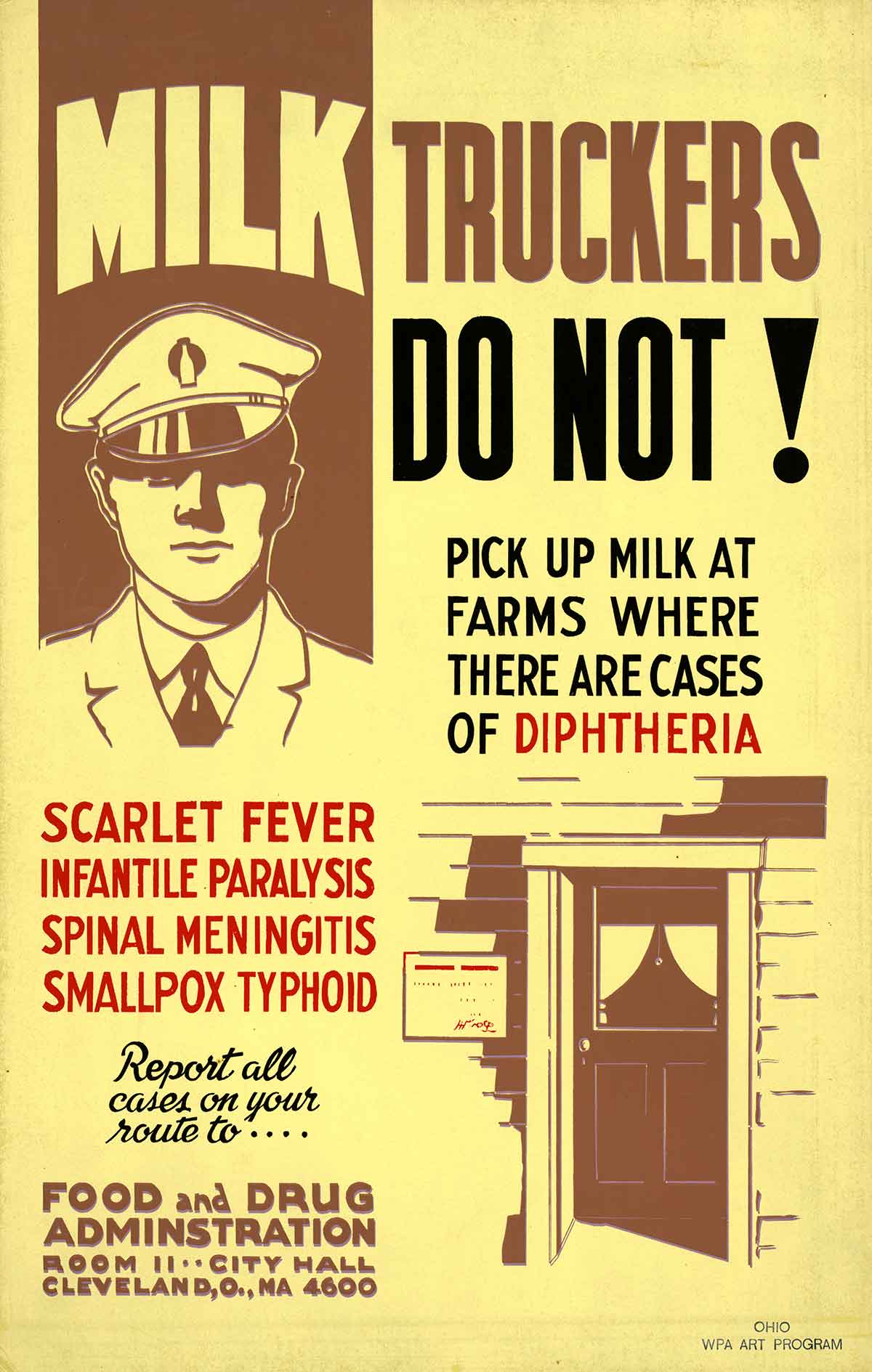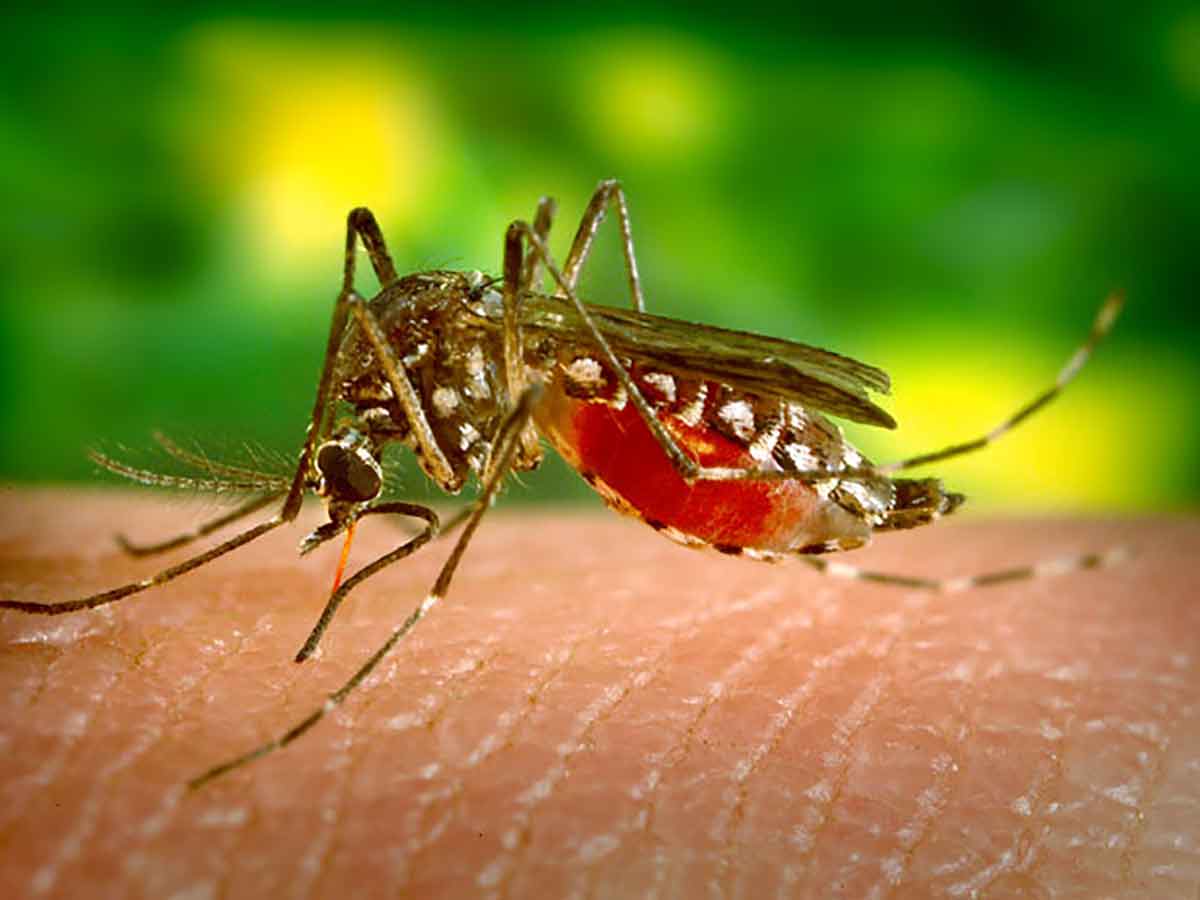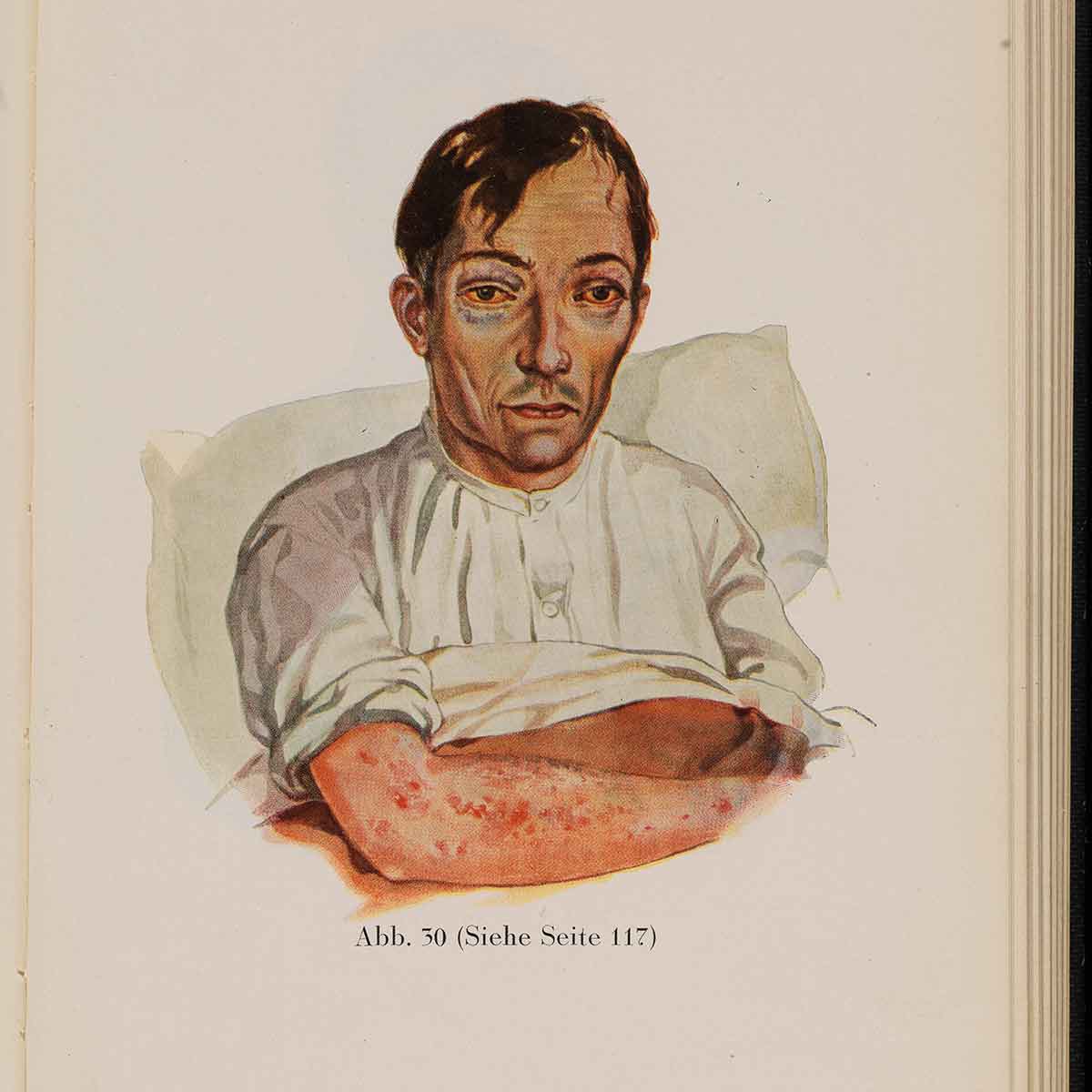Scarlet Fever

First documented in the 1500s, scarlet fever is a bacterial illness that develops in some people who have strep throat. It is characterized by a high fever and bright red rash that covers most of the body. Scarlet fever is most common among children and was once considered a serious childhood illness since it could lead to life-threatening complications with the heart, kidneys, and other parts of the body.
The 1800s Scarlet Fever outbreak seems so far ago that it’s hard to understand the impact it had on the world. Some experts believe that the death rate for the Scarlet Fever during this particular outbreak was as high as 150,000. Some victims contracted this infection and would die within 48 hours. The worst statistic is that Scarlet Fever affected children the most – between the ages of 5 and 15.
Scarlet Fever

The good news is that antibiotics really helped decrease the number of deaths from Scarlet Fever. The bad news is that those medications didn’t come along until the early 1900s. Thanks to that, Scarlet Fever was almost eradicated in the 1960s. It’s a big shame that it didn’t stay that way.
In 2015 more than 14,000 people were diagnosed with the disease in the UK, which is the highest volume there has been in 20 years, according to British health authorities. The reason why it's coming back so strong now? It's mutated. Professor Mark Walker states that it's acquired "superantigen toxins," which helped it spread even more than it had previously.
Rickets

Rickets may not technically be a disease, but everyone thought it was gone for good. This skeletal disorder causes softening and weakening of bones in children. The symptoms are quite clear for most children – bowed legs, stunted growth, and a large forehead. Some may also experience trouble sleeping and complications like bone fractures, muscle spasms, and a curved spine.
It can be brought on by a lack of Vitamin D in a person’s diet. If caught early, symptoms can be reversed. Rickets was observed as early as the first and second centuries AD, but it wasn't named until 1645. One of the most notable outbreaks was in the mid-1800s. By 1918, the link between Rickets and poor diet had become quite clear.
Rickets

This meant that we were on our way to getting rid of the skeletal disorder altogether. In fact, there weren’t any notable cases for a long, long time. Unfortunately, that’s no longer the case. Whether it’s because of an increase of disorders like celiac disease or due to a poor diet, there have been increases in cases in developed places like the United States and Europe.
England found that there were over 100,000 hospital admissions due to Vitamin D deficiency. That's a 34% rise from the previous year. Those numbers kept going up year-over-year as well. A study by the Mayo Clinic looked at the children that were diagnosed with Rickets in the United States and found that the majority of them were caused by nutritional deficiencies. While the disease still remains rare, it's dramatically increased since the 2000s.
Gout

Gout is a form of painful arthritis that is caused by an accumulation of uric acid in the joints, usually in the toes, feet, and legs. The first documented case of this disease was in Egypt in 2600 BC. It used to be known as the “rich man’s disease,” since eating rich, fatty foods and drinking excessive amounts of alcohol can increase your risk.
In fact, some of the most notable cases in history are from royalty all over the world including King Henry VIII. Turns out that a lot of the founding fathers also had gout, including Franklin and Jefferson. Historians think that John Hancock also used gout for political leverage. Instead of signing the Constitution, he would use gout as an excuse to buy a little time.
Gout

It's no surprise that Americans’ diet is extremely unhealthy. The rise of fast food and unhealthy food additives has caused pretty much everyone to suffer from this disorder whether they’re rich or poor. In the medical journal Arthritis & Rheumatology, there were 41.2 million cases of gout worldwide in 2017.
The same study was conducted in 1990. Comparing the two shows a 5.5% increase of gout cases. That number is only rising. The study also stated that gout was prevalent in the highest in developed regions and countries. Scientists and health experts agree that as obesity rates increase, gout cases will also be on the rise.
Syphilis

Syphilis is a sexually transmitted infection that first appeared in Italy in 1494. It was so bad back then that they called it the “grand pox.” For over 400 years, this deadly disease was untreatable until the discovery of penicillin in 1943. While Syphilis didn't have the mortality rate of other diseases and plagues, the symptoms were painful and repulsive.
It wasn’t like the remedies were much better. They were overall ineffective against the infection itself while others were dangerous and awful. One treatment involved mercury inunctions. This just caused people to suffer from mercury poisoning. In WWI, syphilis was actually the second-most common reason for disability and absence from duty.
Syphilis

After penicillin was invented and showed to be an effective treatment against syphilis, there was hope. Actually, the STI was almost completely eradicated in the United States. On top of that, cases in developed countries were dramatically decreasing…until recently. This time, however, the threat is a lot more dangerous.
A press release in 2019 by the CDC announced that there was a growing threat of newborn deaths from syphilis. There were more than 115,000 cases from 2017 to 2018, with the most infectious stages increasing 14% since 1991. One big reason could be linked to methamphetamine users, who contract the STI by sexual contact or through sharing paraphernalia.
Measles

Measles is a viral infection that can be serious and even fatal for small children. In the last 150 years, measles was estimated to have killed over 200 million people around the world. In 1912, the cases began being diagnosed and reported to U.S. healthcare providers and labs, and the first decade alone had an average of 6,000 deaths per year in America alone.
Then came something miraculous. In the 1960s, a vaccine was created that hoped to combat the constant deaths from this infection. Measles vaccines got better and better, and by 1978, the CDC set a goal to eliminate measles from the United States by 1982. It was an aggressive goal but totally achievable.
Measles

Skipping ahead to 1981, measles cases had decreased a whopping 80% since the year prior. Then came the tale that would ruin everything. The medical journal The Lancet published a “study” that linked the MMR vaccine to autism. Since then, vaccination rates have been steadily decreasing as parents choose not to vaccinate their children.
In 2012, there were 122,000 deaths caused by measles worldwide. It's not just the United States, however. The cases are increasing at alarming rates all over the world. From 2018 to 2019, deaths from measles climbed to 50% 2016 to 2019, according to the World Health Organization. In developed countries, this is due to parents not vaccinating their children. In underdeveloped countries, it’s a lack of access to vaccines.
Mumps

Mumps is a highly contagious viral disease that causes swelling in the parotid salivary glands in the face. While it’s rare for someone to die from mumps, it’s still a pretty painful, serious illness. It prevented children from playing, going to school, or interacting with anyone outside of their household.
Mumps is one of those diseases that's been around forever, but it wasn't identified until the early 1900s. Scientists immediately got to work trying to isolate the virus to create a vaccine that would help prevent outbreaks. There was one created in the '40s, but it was short-lived and discontinued in the '70s when better vaccines became available.
Mumps

After the golden age of vaccines in the ‘70s, mumps cases dropped dramatically until theThe Lancet “study” that “linked” autism to vaccines. The vaccine fears dramatically decreased vaccination rates and mumps (along with other nearly-gone illnesses) started to return all over the world. Cases started to increase as a result.
However, things really got bad in 2016 when studies from Harvard found that there was a huge rise in mumps cases among those who had received the vaccine. Turns out the vaccine wasn’t a lifelong fix. The vaccine only lasts about 27 years, and that explained the sudden increase on college campuses. The study suggested another dose at 18 to prevent further mumps outbreaks.
Polio

Polio is a deadly virus that can cause paralysis and difficulty breathing. The first documented case of polio was in 1789, but a worldwide polio epidemic occurred in the mid-twentieth century. In the 1940s and '50s, polio killed an average of 35,000 people in the United States each year and nearly half a million people around the world.
It was easily one of the scariest diseases that's ever existed, with its effects sticking around if the illness doesn't claim the person's life. Thankfully, the vaccine for polio practically eliminated it in the Western Hemisphere in 1994. The only problem is that it’s in other countries all over the world, meaning it's still out there.
Polio

Vaccinating everyone in the world is the only way to prevent this disease from coming back and creating another outbreak that will bring back the dreaded iron lung. The World Health Organization has led efforts to vaccinate underprivileged places like Niger, Chad, and Pakistan, where it isn't uncommon to see hundreds of cases per year. However, the US may see its own outbreak soon enough.
Aaron Siri, the lawyer of Donald Trump's nominee for United States Health Secretary Robert F. Kennedy Jr., has asked the F.D.A. to revoke approval for the polio vaccine in America. The petition was filed in 2022, but Siri is in the process of helping RFK Jr. choose federal health officials for the upcoming Trump administration, so it's possible the approval for the vaccine could be revoked soon. This would make US citizens vulnerable to the virus that causes paralysis or death.
Yellow Fever

Transmitted by mosquitoes, yellow fever is a disease that affects the liver and kidneys. It causes fever, jaundice, and usually, death. One of the most catastrophic outbreaks of this disease was in Philadelphia in 1793 when it killed 5,000 people. This was 10% of the city’s population, which left the rest fearing for their lives.
Yellow Fever continued to decimate populations all over the world. In New Orleans alone, it was recorded that over 41,000 people died of this disease between 1817 and 1905. Since it spread easily through mosquitos, places like New Orleans and Louisiana were at a high risk of a major outbreak.
Yellow Fever

When the Yellow Fever vaccine began being administered, it seemed to disappear. However, that was more or less limited to first-world countries. Everywhere else, Yellow Fever continues to thrive with over 200,000 cases per year. The most recent World Health Organization stats show an immunization coverage of 51% in 2007 for countries where an outbreak is possible.
The scariest part is that the disease is spreading quite quickly now. In 2013, disease-carrying mosquitoes were discovered in some southern American cities. This is where it thrived in the early 1800s. This means Yellow Fever could take root again, especially in poor communities. So far, the best way to avoid Yellow Fever (outside of the vaccine) is to prevent mosquitos from nesting and spraying bug spray.
Whooping Cough

Whooping cough, named because it is marked by severe, hacking cough, is a highly contagious respiratory tract infection. It was first noted in the Middle Ages and ran rampant for centuries. It requires the person to isolate themselves anywhere from seven days to a full month. Sometimes, the symptoms don’t go away for months afterward.
The vaccine was available pretty early on in the 1940s. That was great news for parents considering children under the age of one had a 50% hospitalization rate and around one in 200 would die from the infection. Nearly eradicated in 1976 with only 1,010 cases of the disease that year.
Whooping Cough

Then suddenly, there was a resurgence and cases were on the rise once again. In 2016, the United States saw nearly 18,000 whooping cough cases, including six infants who passed away. The reason? The number of vaccinations needed to protect someone against Whooping Cough long-term. Right now, it’s around five to six!
Since the current vaccine only offers temporary immunity, after the age of 11 or 12, you become susceptible to the disease again without receiving a booster. The CDC has also recommended that adults older than 19 get Tdap shot as well. Some blame the anti-vax movement for the cases to jump up to the tens of thousands once again. Others say a better vaccine needs to be made.
Gonorrhea

Gonorrhea is a sexually transmitted infection that, if left untreated, can lead to serious health complications. Sometimes referred to as “the clap,” this STI is one of the oldest known to mankind. It's affected many people throughout history, even going as far back as spreading throughout Julius Caesar’s Roman army.
It's impossible to know when the greatest outbreak was considering health standards were beyond subpar compared to modern-day – you simply didn’t have to report it. Treatment wasn’t much better since it could include using mercury or silver nitrates to control the infection. Thankfully, today we have antibiotics, only there’s a catch there, too.
Gonorrhea

In the past, this condition could easily be treated with antibiotics like ceftriaxone and azithromycin. Over time, gonorrhea has been able to adapt to our antibiotic treatments and become resistant to what we have available. For example, penicillin used to be the first line of defense to combat gonorrhea, but it’s since become completely resistant to it.
Today, we have one of the most resistant forms of infection to date. On top of that, it’s spreading very quickly. In 2018, the United States reported that there were nearly 600,000 gonorrhea cases, which was a 63% increase from 2014. Currently, scientists are working on creating a vaccine, but until then, the best way to avoid gonorrhea is abstinence. The next best way is condoms.
The Plague

The Plague is one of those diseases we all know about and learned about in school. It ravaged the world in the Middle Ages, leaving no group untouched whether they were rich, poor, or royalty. No one knew how to stop it, and after just four years, it killed nearly 25 million people in Europe and 450 worldwide. At the time, that was a third of the world's population.
Worst of all, it seemed to come back from time to time. After all, people back then didn’t know where it came from or how to stop it. Eventually, it just sort of went away and people assumed it was a thing of the past. The last real major outbreak was during the early 1900s, so why should we be worried about the plague today?
The Plague

Unfortunately, it’s back. It never really disappeared completely. It popped up from time to time in underdeveloped regions around the world, but health experts are becoming more and more concerned. Mostly since it has begun to pop up around the United States in states like Colorado, New Mexico, and California. Thanks to modern advancements, we currently know how to treat the plague.
However, newer strains of the plague are making scientists concerned. There was a deadly outbreak in Madagascar that killed 170 and infected thousands. Another outbreak occurred in Yemen, which shut down an entire neighborhood (a common Chinese practice to contain disease). Since the introduction of antibiotics, the fatality rate was 11%, but drug resistance is making that number grow once again.
Tuberculosis

Tuberculosis is a lung disease most known for its tell-tale cough and bloody mucus. Historically, it was called consumption, which is something that may ring a few bells for many readers. It easily spread from one person to another through coughing, speaking, or sneezing. Once one person gets it, it burns like wildfire.
Back in the day, no one knew why tuberculosis existed. It was often attributed to vampires prior to the industrial revolution. It wasn't until the late 1600s that it was defined as a disease, but nothing could really be done about it. In 1815, one in four deaths in England was caused by TB. In 1918, one in six deaths in France were also TB-related.
Tuberculosis

While we may mistakenly consider it an "old" disease, it is still very much present in the modern-day. After seeing a decline in tuberculosis cases for almost two decades, the number of annual cases began to rise in 2015. Thankfully, we've begun to see a drop in cases again, but experts still aren't sure what could have caused the spike and how they can prevent it from happening again.
The worst part about tuberculosis is that it's so hard to treat. It attacks the cell in such a way that entry of drugs is difficult and renders many antibiotics ineffective. Right now, we can only hope that it can be contained since there’s no way to combat it when it rages through populations like it did in previous centuries. All most can do is create isolation wards to contain the disease while they can.
Rubella

Rubella, aka German measles, is another one of the diseases prevented by the childhood MMR vaccine. This disease is often mild, with most people never knowing they even had it! It typically presented itself with an itchy rash and swollen lymph nodes that would last a few weeks. Sometimes, fever, sore throat, and fatigue may also occur.
That being said, mothers can pass rubella onto their babies which could lead to cataracts, deafness, and heart and brain problems. The good news is that a single dose of the MMR vaccine prevents more than 95% of the cases. For most developed countries, Rubella almost became a thing of the past….almost.
Rubella

Cases of the Rubella aren’t extremely common today, but decreased vaccination has sent the medical community into a frenzy. The infection can spread very quickly, especially among those that haven’t been vaccinated. This became apparent in 2019 when Rubella spread rampantly through a Detroit Auto Show.
Someone that was infected with Rubella attended the show, which led to several people contracting it. The scariest part is that Rubella can live outside of the body for over 21 hours on a variety of surfaces we touch every day. This has prompted doctors to encourage parents to please vaccinate their kids before it turns into a full-blown outbreak in the United States.
Cholera

Cholera is a condition that can leave a healthy adult dehydrated and dead in a matter of hours. One of the first Cholera accounts it absolutely terrifying. It occurred in 1543 in the Ganges Delta. It killed victims within eight hours of developing symptoms, and the fatality rate was so high that it was hard to bury all the dead.
Spread through contaminated water, it made its way through countries all over the world, with the 1800s being one of the most notable outbreaks. The pandemic lasted six years and killed hundreds of thousands, including some deaths in the Americas. By the late 1800s, it was discovered it spread through water, and steps were taken to avoid it from happening again.
Cholera

However, that doesn’t mean Cholera is gone for good. In developed countries, cholera is still a highly rare occurrence, but that's not the case in underdeveloped countries. Outbreaks there can be much more common--and just as deadly as they used to be. In Nigeria, there was a Cholera outbreak that's topping 80,000 cases and nearly 3,000 deaths.
It's rare to hear of a case in the United States or other developed countries, but that doesn't mean it doesn't happen. In 2010, there were 23 reported Cholera cases in the U.S., which caused an epidemic in Hispaniola. Keeping clean water is the only way to really prevent the disease. There are also treatments available, but Cholera works fast…sometimes too fast.
Chlamydia

Chlamydia has been around for a long time, but it didn't become a recognized STI until the 1970s. Because of the way it is transmitted, it's difficult to know exactly how many outbreaks there have been in the past. However, thanks to modern-day tracking, we know that Chlamydia is now one of the most common sexually transmitted diseases out there.
The worst part about Chlamydia is that some people infected with it don't even show any symptoms. They can spread it willy-nilly without knowing otherwise. Remember that fact when you hear this next one: it was discovered in 1907. That means it spread unchecked for 70 years! That’s definitely a harrowing thought.
Chlamydia

The good news is that it’s treatable. The bad news is that it’s becoming increasingly drug-resistant. STIs are very skilled at adapting to whatever they throw at them. This has caused it to become an increasing threat over the years. The CDC estimates there are approximately one million chlamydia infections that go undiagnosed every year. Many cases are found on college campuses where students don't have access to health care.
Just last year, there were 1.8 million cases actually reported, which was a 20% increase from 2014. Chlamydia itself isn’t deadly, so that’s the good news. The bad news is that it can cause a number of other health issues like infertility, inflammation, and pelvic pain. It can also cause a woman to lose her baby if she’s pregnant.
Scurvy

Ah, yes – the pirate disease. Scurvy is a disease that's caused by a lack of Vitamin C in the diet. It can cause weakness, tiredness, sore arms, legs, decreased red blood cells, damage to the gums and hair, and could even result in death if left untreated. People have known how to cure scurvy for years, as far back as the 13th century.
That being said, it hasn’t stopped people from suffering from it. During the Age of Exploration, Scurvy killed at least two million sailors. Much of this was because there wasn’t access to fresh fruit while sailing across the ocean (and fridges wouldn’t be invented until 1834). It’s crazy to think people knew how to prevent Scurvy and fix it, but they just didn’t.
Scurvy

Sadly, it's coming back (and we still know how to fix it). Malnutrition isn't something most people think of when it comes to countries like the United States and the United Kingdom. Still, cases are popping up all over. ScienceAlert reported that there are anywhere between 20 to 30 cases of Scurvy per year – a number that’s rising due to poor diet.
One Massachusetts man found out he had Scurvy, only to go to the doctor and get a prescription of one orange per day. His doctor is quoted as saying, “Many people who have difficulty affording food tend to go for food that is high fat, high calorie, and very filling.” Naturally, this is also an issue in underdeveloped countries where access to food is beyond limited.
Leprosy

Leprosy hasn't been a concern for a long time. It's a disease that causes damage to the nerves, respiratory tract, skin, and eyes. An infected person has a diminished ability to feel pain and can also experience muscle weakness and poor eyesight. Unlike many of the diseases on this list, leprosy doesn’t spread that easily, and it can take as many as 20 years to affect the person carrying it.
Originally, many early societies believed that Leprosy was a form of divine punishment for worldly sins. Contrary to popular opinion, people didn't isolate themselves in asylums in the Middle Ages. This may have been the reason it spread to be as high as 19,000 cases in Europe alone. Those who did go to a leper colony did so as an attempt to atone for their sins.
Leprosy

Leprosy never went away. It’s always been around, spreading quietly from person to person. The CDC and other health experts are becoming increasingly worried about an outbreak of leprosy, especially in the United States. This has become an even bigger concern as residents of Florida have been diagnosed with Leprosy in the last few months! Physicians are seeing a rise in cases day by day.
That's close enough to spread easily to households in the United States. The physician wrote that leprosy could take hold in Los Angeles County due to its massive homeless population. There are 66,000 homeless people in Los Angeles County alone. Another concern is that Leprosy can be found in animals like armadillos, so avoid them at all costs!
Legionnaires

Legionnaires' disease is a type of atypical pneumonia that can cause cough, shortness of breath, high fever, muscle pain, and headaches. If left untreated, Legionnaires can certainly be fatal. One of the worst outbreaks occurred in 1976 in Philadelphia. More than 2,000 people attended a convention for three days. Soon after, people started dropping dead.
After all was said and done, 182 got sick and 29 died. That was when the CDC started investigating what happened and found that the convention center's air conditioning system had been a breeding ground for the disease. Further investigating showed that it had spread outside of the center, infecting 29 other people.
Legionnaires

Outbreaks like this pop up every so often, including one that just occurred in 2021. The New York City Department of Health announced that there was a cluster of 12 cases. Duke University also reported there were several people sick with the disease. Then there were more cases showing up in Missouri and Michigan. One of the worst places for Legionnaire’s to show up is gyms, where people are sweating and spreading illness easily.
Currently, antibiotics are doing the trick in treating the disease. It only has a fatality rate of 5% if therapy is started quickly. The problem is that hospital-acquired Legionaries aren't so receptive. It has a fatality rate of 28%. The only way to prevent an outbreak with a high death toll is by preventing it and treating people quickly, which can be a task since Legionnaire’s goes largely undiagnosed.
Smallpox

The history of Smallpox is a dark one. During the 18th century, it killed an estimated 400,000 Europeans each year, including five ruling monarchs. It was also responsible for a third of all blindness cases. Most of those who contracted Smallpox would die, especially children who had an 80% mortality rate.
During the 20th century, more than 500 million deaths were caused by this disease. Thankfully, a vaccine was discovered and gave everyone hope. The only issue? People had to take it. The government got involved and issued laws forcing people to get the vaccine. However, thanks to these efforts, Smallpox was eliminated.
Smallpox

It’s been over 25 years since the last Smallpox case, so how much of a threat could it be? Answer: a big one. Some countries have gotten very lax on the Smallpox vaccine whether because they think it isn't important or because they can't afford it. We may be safe now, but our time has been limited all thanks to global warming.
During one of the outbreaks, Smallpox infected bodies were eventually covered with ice. The ice preserved the virus and kept surrounding populations from getting infected. However, global warming is causing that ice to melt. The proof is that there were also bodies infected with anthrax that infected 24 people who had to be hospitalized. Could it spell bad news for us regarding Smallpox? Absolutely.
Spanish Flu

By now, we've all become quite familiar with the Spanish Flu. Also known as the Great Influenza epidemic, it was an exceptionally deadly pandemic that started around 1918. Estimated deaths are around 25-50 million people, making it one of the deadliest pandemics in human history. We haven’t even gotten to the scariest part of it all.
The flu strain that was responsible for this pandemic was the H1N1 influenza A virus. If that sounds familiar, it's because it is. It's also the reason for the 1977 Russian flu pandemic and the 2009 swine flu pandemic. H1N1 pops up every so often, and it hasn’t been much of a concern until now because it’s starting to show up much more often.
Spanish Flu

The biggest recorded pandemics used to be every few decades at most – 1918, 1976 and ’77, 2009, and 2012. The bad news is that there’s been one H1N1 incident nearly every year since 2015. For this reason, scientists are sure that another global flu pandemic is on its way. One researcher who has been studying it for decades says that there’s no controversy about it.
Dr. Greg Poland goes on to say, “I've learned after 30 years of studying this virus is there's next to nothing predictable about it, and when you begin to feel comfortable, you're well on the road to bad things happening.” What’s the best defense we have against something like this happening again? Vaccines. That’s pretty much it.
 Author
Alot Health Team
Last Updated: July 11, 2025
Author
Alot Health Team
Last Updated: July 11, 2025